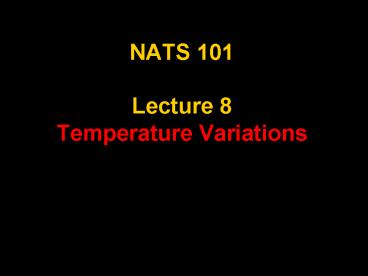NATS 101 Lecture 8 Temperature Variations PowerPoint PPT Presentation
Title: NATS 101 Lecture 8 Temperature Variations
1
NATS 101Lecture 8Temperature Variations
2
Supplemental References for Todays Lecture
- Wallace, J. M. and P. V. Hobbs, 1977 Atmospheric
Science, An Introductory Survey. 467 pp. Academic
Press. (ISBN 0-12-732950-1)
3
Review
- Seasons Due to Tilt of Earths Axis
- Affects Two Things
- Solar Zenith Angle - Length of Day
- Differential Solar Heating and IR Cooling
- Cause of Atmospheric-Ocean Motions
4
Incoming Solar Radiation (Insolation) at the Top
of the Atmosphere
W
C
C
W
Wallace and Hobbs, p346
5
Is Longest Day the Hottest Day?
Consider Average Daily Temperature for Chicago IL
USA Today WWW Site
6
Annual Energy Balance
Radiative Warming
Radiative Cooling
Radiative Cooling
NH
SH
Ahrens, Fig. 2.21
- Heat transfer done by winds and ocean currents
- Differential heating drives winds and currents
- We will examine later in course
7
Temperature Questions
- What causes diurnal temperature variations?
- What physical processes can influence daily
temperature variations? - Why is MAX temperature after solar noon?
- Why is MIN temperature just after sunrise?
- What is Wind Chill Factor? (if time allows)
8
MAX Temperature near Surface
Ahrens, Fig 3.1
Solar SW
Convection
Conduction
9
MIN Temperature near Surface
Outgoing Infrared
Ahrens, Fig 3.3
Absorbed Re-emitted Infrared
Conduction
10
Daily Range of Temperatures
MAX-MIN difference decreases with height above
ground level
11
12 and 00 UTC TUS Sounding
- MAX-MIN Range
- 12oC at 925 mb 6oC at 910 mb 2oC at 800 mb
0oC by 700 mb - Range decreases with height
isobars
isotherms
Diurnal Range
Inversion
12
Growth and Decay of Inversion Evening
Morning
Height
Height
t3
t3
t2
t2
t1
t1
t0
t0
Temperature
Temperature
13
What Affects Inversion Strength?
- Cloud Cover
- Clear skies-strong inversion
- Cloudy skies-weak inversion
- Land Characteristics
- Snow cover-strong inversion
- Bare ground-weaker inversion
- Wind Speed
- Calm winds-strong inversion
- Strong winds-weak inversion
14
Review Is Longest Day the
Hottest Day?
Average Daily Temperature for Chicago IL
USA Today WWW Site
15
When Does MAX-MIN Occur?
- When incoming SW exceeds outgoing IR
- Temperature rises
- When outgoing IR exceeds incoming SW
- Temperature falls
- MAX occurs
- Late afternoon
- MIN occurs
- Just after sunrise
Ahrens, Fig 3.2
16
Winter-Summer Temperature Variations at Sea Level
DJF
Ahrens, Figs. 3.8, 3.9
100oF
10oF
- Continents undergo larger changes than oceans
- High latitudes undergo larger changes than low
latitudes
JJA
17
Controls of Temperature
- Latitude
- Average temperatures in middle latitudes
decrease by 5-10oC every 10o latitude - Elevation
- Lapse rate in troposphere is 6.5oC/km
- Tucson (2,500 ft) July Max - 100oF
- Mt. Lemmon (8,500 ft) July Max - 76oF
18
Controls of Temperature
- Ocean Currents and Prevailing Winds
- Warm-Gulf Stream
- Cold-California Current
- Land versus Water
- Heat capacity of water is 5X that of land
- Absorbed solar energy is distributed a greater
depth in water than in land
19
Specific Heat Capacity
- Heat required to raise temperature of 1 gm of
mass 1oC. - Rock has lower heat capacity than water
20
Water-Soil Heating Depth
21
Soil Temperature
Wallace and Hobbs, p347
22
Ocean Temperature
Wallace and Hobbs, p348
23
Ice Formation
Wallace and Hobbs, p348
24
Wind Chill
- Still air is poor conductor lack of wind allows
insulating layer of still air to form near skin - Wind blows insulating layer of air from skin
Forced convection or heat transport by advection
25
Summary
- Balance between incoming and outgoing energy
controls temperature rises and falls - MAX late afternoon, MIN just after sunrise
- Diurnal temp. changes are largest at ground
- Affected by wind, cloud cover, land type
- Winter-Summer changes
- Largest over land, high latitudes
- Temperature Controls
- Latitude, Altitude, Land-Sea, Ocean Currents
26
Assignment
- Ahrens
- Atmospheric Moisture
- Pages 77-89, B 430, D 433-436
- Problems 4.1, 4.2, 4.5, 4.6, 4.9, 4.10

